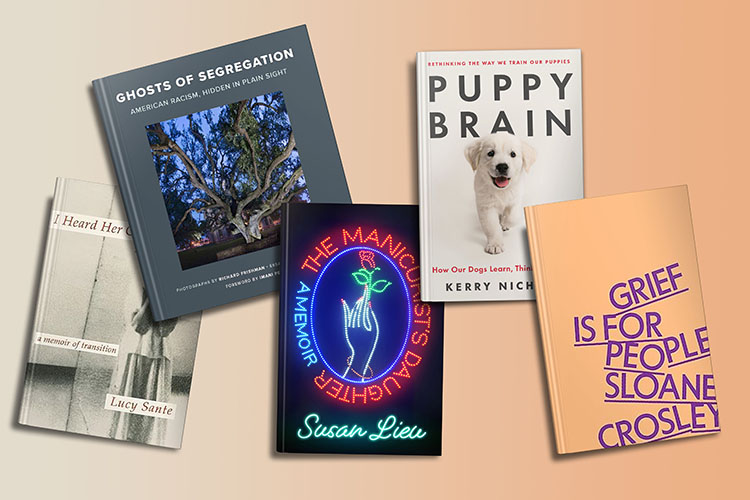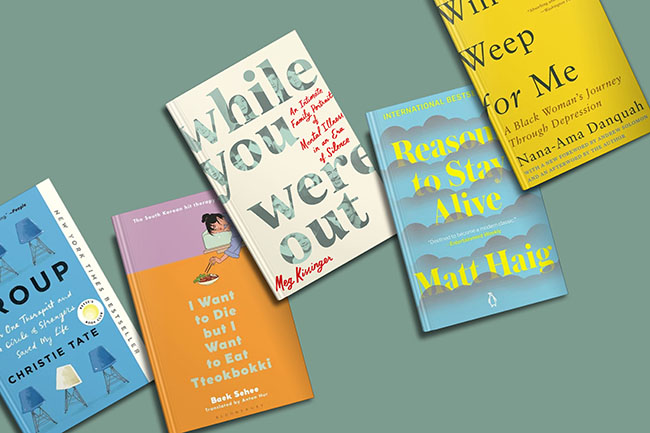No doubt you’ve heard about psychedelics and their use to treat mental health issues. But what exactly is psychedelic therapy? What drugs are used and how are they different? We’re answering these questions and more, plus giving you tips for further reading on the topic.
By Megan Draper
The world of psychedelics and psychedelic therapy changes by the day. What was once a fringe and heavily stigmatized field in the United States is entering the mainstream. Indicators of our growing interest in psychedelic therapy can be seen everywhere: from campaigns to legalize psychedelic-assisted therapy at the federal level to a wave of revelatory books that dive deep into the topic.
Journalists, like The New York Times correspondent Ernesto Londoño, have been investigating this new modality for the past few years. In Londoño’s upcoming book, Trippy: The Peril and Promise of Medicinal Psychedelics, readers get an intimate look inside ayahuasca retreats in Latin America; meet veterans with PTSD undergoing treatment at psychedelic churches and learn how far psychedelic treatments have come since the Nixon era.
But what is psychedelic therapy? How does it work? And what are the risks? Keep reading for the answers to these questions and a few of our favorite mind-expanding books about psychedelics.
What Is Psychedelic Therapy?
Psychedelic therapy, also known as psychedelic-assisted therapy or PAP, entails using psychoactive substances, oftentimes alongside talk therapy, to treat conditions such as depression, anxiety and post traumatic stress disorder.
According to Psychology Today, psychedelic therapy has shown promise to treat substance dependence, chronic PTSD, obsessive compulsive disorder, among other conditions. Other studies have investigated the potential benefits of psychedelic-assisted therapy for people diagnosed with eating disorders and terminal illnesses.
Treatment is often administered through microdosing. Microdosing is when a patient ingests very small amounts of a drug at intervals in hopes of inducing the drug’s benefits without experiencing severe mind-altering effects like hallucinations or dissociation. Medical News Today states that microdosing can potentially induce mystical and meaningful experiences, increase suggestibility and receptivity, and stimulate neurotransmitters, which can alter brain activity in ways that improve a person’s mood and outlook.
Though a provider may give a patient a psychedelic drug with no additional treatment, psychedelic therapy is often paired with other forms of therapy. This might involve a hybrid approach where a provider offers treatments like talk therapy or mindfulness-based interventions alongside psychedelic-assisted therapy.
What Drugs Are Used in Psychedelic Therapy?
A variety of psychedelics are being used in therapy and studied for therapeutic purposes. A Healthline article published in 2021 lists the most common drugs being used in treatments today as ketamine, MDMA, psilocybin, and LSD. DMT, a naturally occurring substance that Londoño explores in Trippy, is also gaining interest as a psychedelic therapy drug. Here’s a look at these drugs and what they can do:
Ketamine is an anesthetic commonly used in veterinary and human medicine. At low doses, it can induce a dissociative, psychedelic-like state. In recent years, clinicians have prescribed it off-label to treat depression in patients who have not improved with standard treatments. Preliminary studies have shown that ketamine is a promising intervention for people with suicidal ideation.
MDMA, also known as ecstasy, is a chemical compound that generates feelings of euphoria. It’s recently seen clinical trial success in treating PTSD. It’s also been used to treat substance dependence and social anxiety.
Psilocybin is the psychoactive ingredient in magic mushrooms. It’s a naturally occurring substance that induces awareness-heightening trips that last several hours, with residual feelings lasting even longer. Promising clinical studies throughout the United States may be moving this drug toward wider legalization for the treatment of depression, anxiety, and substance use disorders.
LSD, also known as acid, is a chemical compound that has shown promise in treating alcohol addiction, depression, and anxiety in people with life-threatening illnesses. LSD sessions can lead to feelings of bliss and a sense of connectedness with others.
DMT is a compound that can cause blissful out-of-body experiences. A naturally occurring substance derived from plants and some animals, DMT has been used for centuries in religious ceremonies and sacred Indigenous rituals throughout South America. The ayahuasca ceremony, which Ernesto Londoño explores at length in Trippy, is an example of a DMT-based psychedelic experience that participants have found to be of great benefit to their mental and spiritual well-being.
Are There Risks to Psychedelic Therapy?
All substances come with potential risks, and psychedelics are no exception. As explained in The New York Times, psychedelics have an extremely low risk of a lethal overdose. The likelihood of addiction is also low, yet that doesn’t mean that psychedelic treatment is entirely safe.
Ketamine, psilocybin, and other hallucinogens can trigger psychotic or manic episodes. Though the available evidence is not yet conclusive, the likelihood of triggering serious psychiatric disorders may be higher for people with a family history of schizophrenia or bipolar disorder. Additionally, challenging trips with LSD or DMT may cause lasting psychological trauma.
There are also physical risks associated with psychedelics. Most hallucinogens produce their effects by activating a specific serotonin receptor, 5-HT2A. This receptor is closely related to the serotonin receptor 5-HT2B, which has been linked to valvular heart disease. Though the chance of developing valvular issues after a few uses is extremely low, microdosing might be dangerous for people with cardiovascular conditions.
Additionally, a patient’s specific medical history or current medications may increase their risks. Patients with a history of epilepsy may risk triggering a seizure. Those with traumatic brain injuries are at risk of raising intracranial pressure to dangerous levels. Patients taking antidepressant drugs that affect serotonin levels should be aware that taking psilocybin treatments could cause serotonin syndrome. Similarly, ketamine, which has a strong sedative effect, can be dangerous when combined with other sedating medications, such as opiates, muscle relaxants, or benzodiazepines.
While psychedelic therapy has great potential, it’s essential to remain mindful of the possible dangers involved. Supervised therapeutic settings conducted by medical professionals are the best way to minimize risk. Continued research will help guide prospective users to the best medical practices and establish a safer, more effective environment for patients and practitioners alike.
The Future of Psychedelic Therapy
In a study conducted in 2019 on the benefits and challenges of psychedelic microdosing, participants ranked “illegality” as the top challenge they experienced. In other words, it was concerns over the illegality of the substance itself — the drug’s availability or its cost, a fear of social stigma surrounding use — that represented the greatest drawback. However, the legal consequences of using psychedelic drugs in a therapeutic setting may soon be a concern of the past.
According to The New York Times, the Food and Drug Administration is widely expected to approve MDMA to treat PTSD in 2024. In 2020, residents of Oregon voted to legalize the use of psilocybin; in 2022, residents of Colorado followed suit. It seems the United States is opening its mind to the use of psychedelics and psychedelic-assisted therapy.
While there’s still a great deal to learn about psychedelic therapy, the emerging research is promising. With advocates working to expand clinical research studies, decriminalize certain psychedelic substances, and ensure greater safety for all, the field of psychedelic therapy evolves by the day.
What Are the Best Books About Psychedelic Therapy?
If you’re looking to expand your understanding of psychedelics and psychedelic therapy, the following acclaimed books will enlighten and educate you in equal measure.
Trippy: The Peril and Promise of Medicinal Psychedelics by Ernesto Londoño
Set for publication in May 2024, Trippy offers an eye-opening look at the past, present, and future of medicinal psychedelics. In a Brazilian rainforest in 2018, New York Times reporter Ernesto Londoño took his first dose of DMT, seeking to alleviate the deep depression that nearly led him to take his own life just weeks before. The life-changing experience propelled Londoño on a journey to understanding psychedelic therapy, the results of which he chronicles here. Deeply researched and interlaced with Londoño’s compelling personal narrative, Trippy is a riveting up-to-the-moment examination of the benefits and dangers associated with using psychedelics in mental health treatment.
How to Change Your Mind by Michael Pollan
Inspired by his own psychedelic journey, bestselling author Michael Pollan explores the medical and scientific revolution surrounding psychedelic drugs in How to Change Your Mind, published in 2018. Pollan blends scientific investigation and memoir with travel writing and history to create his engaging narrative, dismantling myths as he makes a case for the healing potential of psychedelics and the limitless expanse of the human mind.
The Promise of Psychedelics: Science-Based Hope for Better Mental Health by Dr. Peter Silverstone
The Promise of Psychedelics is an engaging and eminently readable guide to the emerging field of psychedelic therapy. In it, Dr. Peter Silverstone explains the different types of psychedelics, how they work, and why they’re poised to revolutionize the field of medicine, all while highlighting psychedelic therapy’s potential to help millions of people.
A Really Good Day: How Microdosing Made a Mega Difference in My Mood, My Marriage, and My Life by Ayelet Waldman
Ayelet Waldman was tired of failed medications and at an all-time low when she began using therapeutic microdoses of LSD. The results changed her life, from her mood and productivity to her relationships with her loved ones. Personable and humorous, A Really Good Day follows Waldman as she navigates her treatment and explores the history and promise of LSD in the therapeutic setting.



